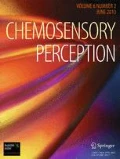Abstract
Introduction
Flavor is known as one of the main criteria that influences food choice. For flavor to be perceived, it needs to be released from the food. Prior studies on mechanisms that govern flavor release have largely focused on interactions with food/ingredients and have analyzed a single flavor modality (aroma or taste). The lack of comprehensive methods has limited our understanding of flavor release from food.
Aim
The aim of this study was to comprehensively monitor flavor release by conducting a mass balance analysis (exhaled air, saliva, and gum bolus) of both volatile aroma and non-volatile taste compounds during mastication of chewing gum.
Methods
Concentrations of volatiles (ethyl butyrate, benzaldehyde, menthol, menthone, and limonene) and non-volatiles compounds (sorbitol, aspartame, and acesulfame K) were determined over a 12-min mastication time period in expectorated saliva, gum bolus, and exhaled breath (only for volatiles) using LC/MS/MS, GC/MS, and atmospheric pressure chemical ionization-MS.
Results
The percent release of the volatile compounds during mastication was lower when compared to the non-volatile compounds. The aroma release profile in the exhaled breath was not related to the compound concentration in the saliva or gum bolus. Results suggested the aroma release was primarily controlled by residual levels of these compounds in the oral cavity and/or the lungs. Similarly, the release profiles of the non-volatiles were not concentration dependent during the first 4 min of mastication, suggesting physical entrapment in the gum base and subsequent release when exposed to the oral cavity for extraction via mechanical stress during mastication.
Conclusions
Two main mechanisms of flavor delivery from chewing gum were supported based on a mass balance analysis: (1) the renewal of the gum bolus surface area and (2) the absorption of the aroma compounds in the oral cavity or lungs as an important mechanism of aroma release.
Implications
Our findings provide further insight into mechanisms of flavor delivery and an improved basis to investigate flavor perception of foodstuffs.





Similar content being viewed by others
References
Bots CP, Brand HS, Veerman ECI, van Amerongen BM, Amerongen N (2004) Preferences and saliva stimulation of eight different chewing gums. Int Dental J 54:143–148
Buettner A, Schieberle P (2000) Influence of mastication on the concentrations of aroma volatiles-some aspects of flavor release and flavor perception. Food Chem 71:347–354
Cook DJ, Davidson JM, Linforth RST, Taylor AJ (2004) Measuring the sensory impact of flavor mixtures using controlled delivery. Marcel Dekker, Inc., New York
Davidson JM, Linforth RST, Hollowood TA, Taylor AJ (1999) Effect of sucrose on the perceived flavor intensity of chewing gum. J Agric Food Chem 47:4336–4340
De Roos KB, Wolswinkel K (1994) Non-Equilibrium partition model for predicting flavor release in the mouth: In Maarse H. & van der Heij D.G. (Eds.) Trends in Flavour Research, Proceedings of the 7th Weurman Flavour Research Symposium, Noordwijkerhout, The Nethrlands, June 15–18, 1993
Guinard JX, Zoumas-Morse C, Walchak C, Simpson H (1997) Relation between saliva flow and flavor release from chewing gum. Physiol Behav 61:591–596
Haahr AM, Bardow A, Thomsen CE, Jensen SB, Nauntofte B, Bakke M, Bredie WLP (2004) Release of peppermint flavour compounds from chewing gum: effect of oral functions. Physiol Behav 82:531–540
Harrison M (2000) Mathematical models of release and transport of flavors from foods in the mouth to the olfactory epithelium. ACS symposium series 763. American Chemical Society, Washington D.C., pp. 179–191
Hussein MM, Kachikian R, Pidel AR (1983) Analysis for flavor residuals in the mouth by gas chromatography. J Food Sci 48:1884–1885
Kendall DA (1974) The release of methyl salicylate flavouring from chewing gum. Flvour Ind 5:182–183
Nogourani MK, Janghorbani M, Isfahan RK, Beheshti MH (2012) Effects of chewing different flavored gums on salivary flow rate and pH. Int J Dentistry:2012. doi:10.1155/2012/569327
Overjo-Lopez I, Haar AH, Berg FVD, Bredie WLP (2004) Flavor release measurement from gum model system. J Agric Food Chem 52:8119–8126
Potineni RV, Peterson DG (2008) Mechanisms of flavor release in chewing gum: cinnamaldehyde. J Agric Food Chem 56:3260–3267
Schober AL, Peterson DG (2004) Flavor release and perception in hard candy: influence of flavor compound-flavor solvent interactions. J Agric Food Chem 52:2628–2631
Sostmann J, van Lochem R, & de Roos KB (2003) The influence of gum base composition on flavor release from chewing gum. In: Lequere J.L. & Etievant P.X. (Eds) Flavour Research at the Dawn of the Twenty-first Century, Proceedings of the 10th Weurman Flavour Research Symposium, Beaune, France, June 24–28 2002, pp. 252–255
Taylor AJ (2002) Release and transport of flavors in vivo: physicochemical, physiological, and perceptual considerations. Comp Rev Food Sci Food Safety 1:45–57
Author information
Authors and Affiliations
Corresponding author
Ethics declarations
Conflict of Interest
The authors declare that they have no conflict of interest.
Ethical Approval
All procedures performed in studies involving human participants were in accordance with the ethical standards of the institutional and/or national research committee and with the 1964 Helsinki declaration and its later amendments or comparable ethical standards. The study protocol and consent procedure received ethical approval from the Institutional Review Board (IRB) of the University of Minnesota.
Rights and permissions
About this article
Cite this article
Raithore, S., Peterson, D.G. Delivery of Taste and Aroma Components in Sugar-Free Chewing Gum: Mass Balance Analysis. Chem. Percept. 9, 182–192 (2016). https://doi.org/10.1007/s12078-016-9218-y
Received:
Accepted:
Published:
Issue Date:
DOI: https://doi.org/10.1007/s12078-016-9218-y




